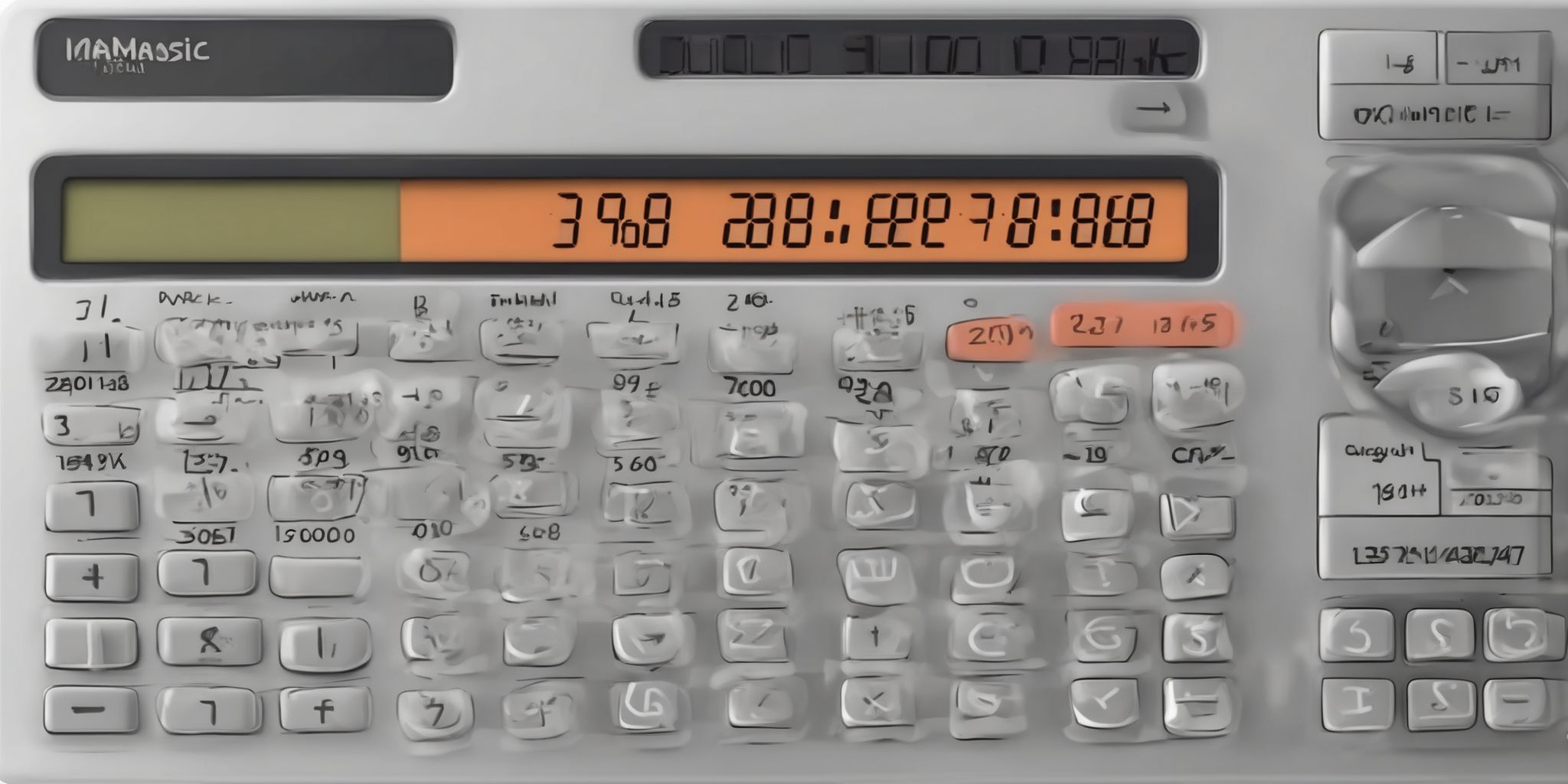How to Use a Retirement IRA Calculator to Plan for Your Future
Retirement - that blissful stage in life where you can finally kick back, relax, and enjoy the fruits of your labor. But to ensure a financially stress-free future, it's important to make solid plans in the present. Cue the Retirement IRA Calculator, a nifty tool that can help you pave the way to a comfortable retirement. So if you’re wondering how to wield this calculator to your advantage, join us as we unravel the secrets of smart retirement planning.
Ready to crunch those numbers with a sprinkle of wisdom? Let's dive in!
What is a Retirement IRA Calculator?
A Retirement IRA Calculator is a digital tool that helps individuals estimate their retirement income based on various financial factors. It considers variables like current age, desired retirement age, contribution amounts, and investment returns. By inputting this information, users can assess their projected earnings during retirement and make informed decisions about their savings strategy.
Why is Planning for Retirement Important?
Planning for retirement is vital because it allows individuals to secure their financial future and maintain their desired lifestyle. Without a clear retirement plan, it's easy to underestimate the amount needed to cover living expenses and suffer financial hardships in later years. By using a Retirement IRA Calculator, individuals can assess their current financial situation and project their retirement income accurately.
This enables them to make informed decisions regarding savings, investment strategies, and potential adjustments to their retirement age or contribution amounts. Planning ahead ensures individuals have sufficient funds to cover necessities, such as healthcare expenses, and enjoy the retirement they have envisioned.
Benefits of Using a Retirement IRA Calculator
Accurate Projection of Retirement Income
Accurately projecting retirement income is a primary advantage of using a Retirement IRA Calculator. By analyzing your current financial situation and estimating future retirement income, you gain valuable insights into your retirement readiness. The calculator takes into account factors such as your current savings, investment returns, and retirement age to provide an estimate of the income you can expect during retirement.
This information empowers you to make informed decisions about your savings and investment strategy.
For example, it may reveal the need to increase contributions or adjust retirement goals to ensure a comfortable lifestyle in the future.
Analyzing current financial situation
- Begin by assessing your current income, expenses, and savings.
- Determine your monthly budget and identify areas where you can cut expenses or increase savings.
- Take note of any outstanding debts or loans that need to be paid off before retirement.
- Consider your current investment portfolio and evaluate its performance and risk level.
- Take into account any other sources of income, such as Social Security or pension plans.
- Ensure you have an accurate understanding of your financial situation to make informed decisions when using a Retirement IRA Calculator.
Estimating future retirement income
Estimating future retirement income is a vital aspect of using a Retirement IRA Calculator. By inputting factors like current savings, investment returns, and planned contributions, you can get a projected figure of your retirement income. This estimation helps you assess whether your savings strategy aligns with your retirement goals.
For example, if the calculator shows a shortfall, you may need to increase your contributions or adjust your investment strategy. Conversely, if the projection exceeds your expectations, you may consider reducing contributions or retiring earlier. A Retirement IRA Calculator empowers you to make informed decisions by providing a realistic outlook on your financial future in retirement.
Scenario Planning
Scenario planning is a valuable aspect of using a Retirement IRA Calculator. It allows individuals to explore different retirement savings options and make informed decisions. By adjusting variables like contribution amounts and retirement age, users can see how these changes impact their projected retirement income.
For example, increasing monthly contributions may result in a higher retirement nest egg. On the other hand, retiring a few years later could provide additional time for savings growth. Scenario planning empowers individuals to consider various possibilities and choose the best path to achieve their retirement goals. It offers a practical way to strategize and optimize retirement savings.
Exploring different retirement savings options
Exploring different retirement savings options allows you to consider various investment strategies to grow your money for retirement. With a Retirement IRA Calculator, you can analyze the potential outcomes of investing in different financial vehicles such as stocks, bonds, mutual funds, or annuities. This helps you understand the risks and potential returns associated with each option.
For example, allocating a percentage of your portfolio to diversified index funds can offer long-term growth potential, while fixed income investments provide stability and predictable income. By exploring these options, you can make informed decisions on how to diversify your retirement savings and optimize your investment strategy.
Adjusting variables like contribution amounts and retirement age
One of the advantages of using a Retirement IRA Calculator is the ability to adjust variables like contribution amounts and retirement age. By inputting different values, you can see how these changes impact your retirement savings.
For example, increasing your contribution amount may result in a higher retirement income, while delaying your retirement age could allow for more time to save. These adjustments allow you to explore various scenarios and make informed decisions about your retirement strategy. Planning for the future becomes easier when you have the flexibility to experiment with different variables using a Retirement IRA Calculator.
Tax Efficiency Strategies
- Maximizing tax benefits is an important consideration when planning for retirement using a Retirement IRA Calculator.
- Traditional IRAs offer tax-deferred growth, meaning contributions may be tax-deductible and earnings grow tax-free until withdrawal.
- Roth IRAs provide tax-free earnings and withdrawals in retirement, but contributions are made with after-tax dollars.
- By understanding the tax implications of each option, individuals can make informed decisions on whether to prioritize tax savings now or in retirement.
- It's essential to consider factors such as current tax bracket, expected future tax rates, and eligibility for deductions or credits.
- Consulting a financial advisor or tax professional can provide personalized insights and help optimize tax efficiency for retirement savings.
Maximizing tax benefits through traditional or Roth IRAs
One way to maximize tax benefits when using a Retirement IRA Calculator is by considering the use of traditional or Roth IRAs. Traditional IRAs allow for tax-deductible contributions, meaning that individuals can reduce their taxable income now and defer paying taxes until retirement. On the other hand, Roth IRAs offer tax-free withdrawals during retirement, as contributions are made with after-tax dollars.
Understanding the tax implications of both options and evaluating which one aligns with your financial goals can help you make informed decisions when planning for your future.
Understanding tax implications at retirement
Understanding the tax implications at retirement is vital when using a Retirement IRA Calculator. Different retirement account types, such as traditional and Roth IRAs, have distinct tax characteristics. Traditional IRAs offer tax-deferred growth, meaning contributions are tax-deductible but withdrawals are taxed as income during retirement. On the other hand, Roth IRAs utilize after-tax contributions, and qualified withdrawals are tax-free.
By comprehending these tax implications, individuals can make informed decisions about their retirement savings strategies to optimize their overall tax situation. For instance, considering factors like current and future tax brackets can help determine whether a traditional or Roth IRA is more advantageous.
How to Use a Retirement IRA Calculator
Gather Necessary Financial Information
To effectively use a Retirement IRA Calculator, it is important to gather the necessary financial information. Start by noting down your current income details, including salary, bonuses, or other sources. Take stock of your existing savings and investments as well. Estimate your future retirement expenses, considering factors such as housing, healthcare, and lifestyle choices. Identifying these financial details will help the calculator provide accurate projections of your retirement income.
By having a clear understanding of your current and future financial situation, you can make informed decisions about your retirement savings strategy.
Income details, savings, and investment information
When using a Retirement IRA Calculator, it is important to gather accurate and comprehensive financial information. This includes:
- Income Details: Provide details about your current income, including salary, bonuses, and any other sources of income.
- Savings: Input the amount you have already saved specifically for retirement, such as in a 401(k) or another retirement account.
- Investment Information: Include information about your current investment portfolio, such as the types of assets you hold and the expected rate of return.
By inputting this information into the Retirement IRA Calculator, you can receive a more accurate projection of your retirement income based on your current financial situation.
Estimation of retirement expenses
Estimating retirement expenses is an important step when using a Retirement IRA Calculator. It helps you determine how much money you'll need during your retirement years. Consider factors like housing, healthcare, daily living expenses, and leisure activities. Plan for both essential needs and discretionary spending.
For example, factor in the cost of housing, including mortgage payments or rent, property taxes, and maintenance.
Additionally, think about healthcare expenses, such as insurance premiums and out-of-pocket costs. By estimating these expenses, you can get a clearer picture of how much you need to save and adjust your retirement plan accordingly.
Choosing the Right Retirement IRA Calculator
When choosing a retirement IRA calculator, it's important to consider its features and user-friendliness. Look for calculators that allow you to input your current age, desired retirement age, and adjust variables like contribution amounts and investment returns.
Additionally, consider the compatibility of the calculator with your personal financial goals. Look for calculators that provide projections of retirement income based on different scenarios. This can help you assess the impact of various factors on your retirement savings. By finding the right retirement IRA calculator, you can make informed decisions to plan for a financially secure future.
Considering features and user-friendliness
Considering features and user-friendliness is crucial when selecting a Retirement IRA Calculator. Look for a tool that offers a clear and intuitive interface, ensuring easy navigation and input of financial information. Features like interactive charts and graphs can help visualize retirement projections effectively.
Additionally, consider calculators that provide customization options, allowing you to adjust variables like contribution amounts and investment returns. A calculator with the ability to save your information for future reference can also be beneficial. By choosing a user-friendly calculator with robust features, you can effectively plan for your retirement without feeling overwhelmed.
Compatibility with personal financial goals
When choosing a Retirement IRA Calculator, it is important to consider its compatibility with your personal financial goals. Look for a calculator that allows you to input specific details about your current financial situation and investment preferences.
For example, if your goal is to retire at a certain age with a specific income target, you want a calculator that can help you determine the necessary contribution amounts and investment returns to achieve that goal. Consider whether the calculator provides flexibility to adjust variables like retirement age, contribution amounts, and investment returns, as this will allow you to align the tool with your unique goals and circumstances.
Inputting Data and Adjusting Variables
- Start by entering your current age and desired retirement age into the Retirement IRA Calculator. This helps determine the number of years you have to save and invest.
- Adjust the contribution amounts to find the right balance between saving for retirement and meeting current financial obligations.
- Consider varying the investment returns to see how different market conditions may impact your retirement funds.
- Experiment with different scenarios by adjusting variables such as retirement age, contribution amounts, and investment returns. This allows you to explore various retirement strategies and make informed decisions.
- Regularly update your information as your financial situation changes to maintain accurate projections for your retirement income.
Entering current age and desired retirement age
When using a Retirement IRA Calculator, one of the crucial inputs is your current age and desired retirement age. Entering these details helps the calculator determine the timeframe available for your investment to grow. The longer the investment horizon, the higher the potential for compound interest to work in your favor.
For example, starting to save early and allowing your investments to grow over several decades can result in a significant retirement nest egg. On the other hand, if you have a shorter timeframe, you may need to consider more aggressive savings strategies or adjust your retirement goals accordingly.
Adjusting contribution amounts and investment returns
When using a Retirement IRA Calculator, it's crucial to adjust both contribution amounts and investment returns to get accurate retirement income projections. Here are some practical tips:
- Increase or decrease contribution amounts: By adjusting the amount you contribute to your retirement account, you can see how it impacts your projected income. Consider increasing contributions to potentially boost your retirement savings.
- Explore different investment return scenarios: Play with varying investment returns to understand the potential impact on your retirement income. However, be cautious not to rely solely on optimistic projections.
Remember, regularly reassessing and adjusting your contribution amounts and investment returns can help you make informed decisions about saving for a comfortable retirement.
Analyzing Retirement Income Projections
- Review annual income projections provided by the Retirement IRA Calculator.
- Assess differences in retirement income based on various scenarios.
- Evaluate the impact of adjusting variables like contribution amounts and retirement age.
- Identify potential gaps between projected income and desired retirement lifestyle.
- Use this analysis to make informed decisions on savings strategies and retirement goals.
- Consider adjusting contribution amounts or retirement age to achieve desired income levels.
- Seek professional financial advice for a comprehensive evaluation of retirement income projections.
Reviewing annual income projections based on retirement savings
Reviewing annual income projections based on retirement savings is a crucial step when using a Retirement IRA Calculator. This analysis provides valuable insights into the financial landscape of your retirement years. By carefully examining the projected income, you can make informed decisions regarding your savings and investment strategies.
For example, if you find that your annual income falls short of your desired retirement lifestyle, you can explore adjusting variables such as contribution amounts or retirement age to bridge the gap. Regularly reviewing these income projections allows you to stay on track and take appropriate actions to ensure a comfortable retirement.
Assessing differences in retirement income based on different scenarios
When using a Retirement IRA Calculator, one valuable feature is the ability to assess differences in retirement income based on various scenarios. This allows you to explore the impact of different factors on your future finances. For instance, you can adjust variables like contribution amounts and retirement age to see how they affect your projected income. By comparing multiple scenarios, you gain insights into the potential outcomes of your savings and investment choices.
This empowers you to make informed decisions and take appropriate actions to maximize your retirement income. Remember, small adjustments today can have a significant impact on your financial well-being tomorrow.
Tips for Maximizing Retirement Savings
Start Saving Early
Start saving early to maximize the benefits of your Retirement IRA Calculator. The power of compounding works in your favor when you give your investments more time to grow. By starting early, even with small contributions, you can accumulate a substantial retirement fund over time.
For example, investing $500 per month for 30 years at an average annual return of 8% could result in a retirement fund of over $1 million. The earlier you start, the more time your money has to grow and the less pressure you'll face as retirement approaches. Don't underestimate the impact of starting early on your long-term financial security.
Take Advantage of Employer Contributions
When using a Retirement IRA Calculator, one important aspect to consider is taking full advantage of employer contributions.
- Employer contributions can significantly boost your retirement savings.
- Many employers offer matching contributions, where they match a certain percentage of your own contributions.
- By maximizing your contributions to meet the employer match, you can effectively double your retirement savings.
- This is essentially free money that can have a substantial impact on your retirement nest egg.
Remember to include any employer contribution details when inputting data into the Retirement IRA Calculator, as it will provide a more accurate projection of your future income.
Consider Catch-Up Contributions
- Take advantage of catch-up contributions to boost your retirement savings, especially if you're 50 years old or older.
- Individual retirement account (IRA) calculators can help you determine the impact of catch-up contributions on your retirement income projections.
- By contributing additional funds to your IRA beyond the standard annual limits, you can accelerate your savings growth.
- For instance, individuals aged 50 or older can contribute an extra $1,000 annually to their traditional or Roth IRAs.
- Utilizing catch-up contributions can make a substantial difference in building a more secure retirement nest egg.
Over to you
Planning for retirement can be overwhelming, but using a retirement IRA calculator can make it easier. This tool helps you calculate how much money you need to save for retirement and how much you should contribute to your Individual Retirement Account each month. The calculator takes into account factors like your current age, retirement age, desired income in retirement, and investment return.
By using this calculator, you can create a personalized plan for your future and make informeddecisions about your retirement savings.


